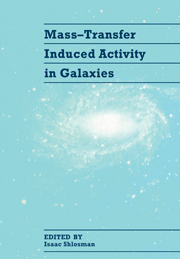Book contents
- Frontmatter
- Contents
- Preface
- List of Participants
- I INTRODUCTION
- II THE INNER PARSEC
- III THE CIRCUMNUCLEAR REGION
- IV GAS DYNAMICS AND STAR FORMATION IN BARRED AND NORMAL GALAXIES
- V NUCLEAR GAS AND LARGE-SCALE PROPERTIES OF AGN AND STARBURST HOSTS
- VI HOST GALAXY-AGN-NUCLEAR STARBURST CONNECTION
- Starbursts, Quasars, and their Environments (Invited paper) 234
- Nuclear Fueling in Two-Component Star-Gas Disks (Invited paper) 251
- Radio Loud Far-Infrared Galaxies 263
- Massive Central Black Holes as Generators of Chaos and Drivers of Large-Scale Dynamics
- Self-Gravitating Gas Dynamics: Growing Monsters and Fueling Starburstsin Disk Galaxies
- Radial Inflows in Disk Galaxies: Effects of Star Formation 279
- Self-Gravitating Gas Dynamics in a Galactic Central Region
- Nuclear Inflow under the Action of Instabilities
- Mid-IR Imaging of Interacting and Non-Interacting AGNs (Poster paper)
- Imaging of MBG Starbursts: Preliminary Results (Poster paper)
- Compact Extranuclear Structures of Mkn 298 (Poster paper)
- NGC 6814: a Very Normal Looking AGN Host Galaxy (Poster paper)
- ROSAT PSPC Observations of NGC 3079 (Poster paper)
- MK 231: AGN vs. Starburst? Steps Toward a Model (Poster paper)
- Extended Starburst Activity Induced by the Central AGN: a Model for NGC 1068 (Poster paper)
- NGC 2782, NGC 4102 and NGC 6764: Evidence for Starburst-Driven Winds
- AGN Winds and Nuclear Starbursts (Poster paper)
- VII GALAXY INTERACTIONS AND INDUCED ACTIVITY
- VIII GAS DYNAMICS IN ELLIPTICALS
- IX AGN AND STARBURST HOSTS AT LARGE REDSHIFTS
- X CONFERENCE SUMMARY
- Subject Index
- Object Index
- Author Index
MK 231: AGN vs. Starburst? Steps Toward a Model (Poster paper)
Published online by Cambridge University Press: 05 May 2010
- Frontmatter
- Contents
- Preface
- List of Participants
- I INTRODUCTION
- II THE INNER PARSEC
- III THE CIRCUMNUCLEAR REGION
- IV GAS DYNAMICS AND STAR FORMATION IN BARRED AND NORMAL GALAXIES
- V NUCLEAR GAS AND LARGE-SCALE PROPERTIES OF AGN AND STARBURST HOSTS
- VI HOST GALAXY-AGN-NUCLEAR STARBURST CONNECTION
- Starbursts, Quasars, and their Environments (Invited paper) 234
- Nuclear Fueling in Two-Component Star-Gas Disks (Invited paper) 251
- Radio Loud Far-Infrared Galaxies 263
- Massive Central Black Holes as Generators of Chaos and Drivers of Large-Scale Dynamics
- Self-Gravitating Gas Dynamics: Growing Monsters and Fueling Starburstsin Disk Galaxies
- Radial Inflows in Disk Galaxies: Effects of Star Formation 279
- Self-Gravitating Gas Dynamics in a Galactic Central Region
- Nuclear Inflow under the Action of Instabilities
- Mid-IR Imaging of Interacting and Non-Interacting AGNs (Poster paper)
- Imaging of MBG Starbursts: Preliminary Results (Poster paper)
- Compact Extranuclear Structures of Mkn 298 (Poster paper)
- NGC 6814: a Very Normal Looking AGN Host Galaxy (Poster paper)
- ROSAT PSPC Observations of NGC 3079 (Poster paper)
- MK 231: AGN vs. Starburst? Steps Toward a Model (Poster paper)
- Extended Starburst Activity Induced by the Central AGN: a Model for NGC 1068 (Poster paper)
- NGC 2782, NGC 4102 and NGC 6764: Evidence for Starburst-Driven Winds
- AGN Winds and Nuclear Starbursts (Poster paper)
- VII GALAXY INTERACTIONS AND INDUCED ACTIVITY
- VIII GAS DYNAMICS IN ELLIPTICALS
- IX AGN AND STARBURST HOSTS AT LARGE REDSHIFTS
- X CONFERENCE SUMMARY
- Subject Index
- Object Index
- Author Index
Summary
ABSTRACT
The infrared luminous galaxy MK 231 appears to exhibit characteristics similar to those of active galactic nuclei — it has been classified as a Seyfert 1 system. However, it has been shown to contain 3 ×x 1010 M⊙ of gas via CO observations. If the CO is confined to the region shielded by dust as in galactic molecular clouds, the molecular gas occupies a much smaller volume than previously thought. The ultimate questions are which characteristic is primarily responsible for most of the luminosity and whether AGN and starbursts are interdependent or coincidental.
THE SUPERGIANT MOLECULAR CLOUD
Scoville et al. (1989) and Radford et al. (1991) have discussed the physical conditions implied by the molecular observations of MK 231. It is inferred from CO observations, that 3 × 1010 M⊙ of molecular gas (H2) resides within a volume of radius RCo < 3 kpc. However, recent infrared observations reveal that the emission from dust at λ ≃ 10 μm arises within a volume of size RIR < 400 pc (Keto et al. 1992). This is an important complementary result to the CO observations because studies within our galaxy show clearly that the molecular gas is largely confined to the region shielded by dust extinction (Young et al. 1982).
- Type
- Chapter
- Information
- Mass-Transfer Induced Activity in Galaxies , pp. 304 - 305Publisher: Cambridge University PressPrint publication year: 1994

